Paper Wasps, Yellowjackets and Other Stinging Wasps
Introduction
Most people have had an unforgettably painful experience with stinging insects so that the sight of such an insect causes fear. However, only a few of the 35,000 species of bees and wasps can inflict a sting painful to man. Many stinging species, such as honey bees, bumble bees, yellowjackets, paper wasps, and many ants, live together in colonies. Their painful sting is used to obtain prey and to defend themselves and their colony. However, most bees and wasps live a more solitary lifestyle and do not aggressively attack intruders. Solitary wasps, such as mud-daubers, cicada-killers, and potter wasps, use venom from their sting to paralyze their insect or spider prey, which they feed to their young. Even if they do sting a person, which is quite rare indeed, it is usually not very painful, as the venom is more suited for paralyzing their insect prey than causing pain to man. In contrast, the stinging wasps inject a venom with powerful pain-causing agents into their victims. Individual responses to a sting may vary from a brief swelling of the immediate area of the sting to a more severe, and potentially fatal, allergic response involving the entire body.
Despite their notorious reputation, wasps are beneficial to man and the “balance of
nature” since some species prey on insect pests of our garden and agricultural crops.
Oklahoma Wasps
Stinging hazard
- Paper wasps (Polistes)
- Yellowjackets (Vespula)
- Baldfaced Hornets (Dolichovespula)
Rare stinging hazard
- Mud-daubers
- Cicada-killers
- Spider wasps
- Potter wasps
Paper Wasps
Paper wasps are colored yellow, black, brown, and red, depending on the species, with 3/4- to 1-inch long slender bodies. They build paper nests of a single comb (Figure 1) attached to trees, shrubs, and a variety of structures, such as building eaves. Their paper nest is derived from weathered wood or plant sources chewed and mixed with the wasps’ saliva.
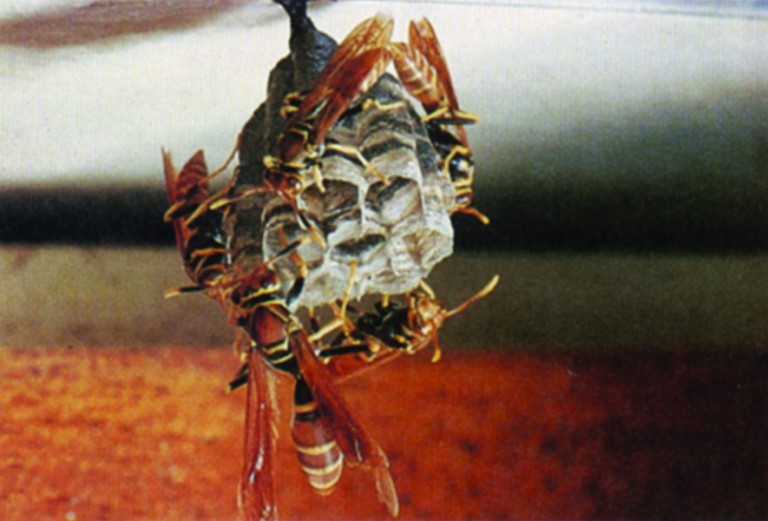
Figure 1. Paper wasps, Polistes exclamans (Hymenoptera: Vespidae) and nest.
The colony begins in the spring when a mated female leaves her hibernation site to build her nest. Usually a single female initiates the nest, but in some species other females may join the original female and help build the nest and care for the young. The emerging young become the workers and gather paper and food, and of course, defend the nest. One of the original females does less colony work and becomes the sole egg layer or queen. The paper wasp queen is not obviously larger than the workers.
The colony grows rapidly through the summer, and the maximum colony size is usually
reached in late summer or early fall. The typical mature paper wasp colony usually
contains 20 to 75 adults on a nest 3 to 10 inches in diameter. These summer colonies
are probably the most defensive and certainly the most threatening to humans. In the
late summer and early fall, males and future reproductive females are produced. As
the workers begin to die in the fall, the reproductives leave the nest to mate.
Mating aggregations occur around elevated structures such as tree tops, towers, and
high-rise buildings and near hibernation sites. Although such large numbers of wasps
would appear to be a dangerous stinging hazard, most of these wasps are males, who
lack a sting, and nonaggressive females primarily interested in mating and hibernation.
After the mating season, the males soon die, while the mated females seek hibernation
sites to survive the winter. The following spring, the annual cycle is repeated as
females emerge from hibernation and initiate a new nest, sometimes in close proximity
to their parental nest. However, they rarely re-use a previous season’s nest.
Paper Wasps
- Body is slender, 3/4 inches long, and variously colored (yellow, brown, red, and/or black).
- Nest is a single open-faced comb made of paper, often attached to building eaves.
- Twenty to 75 wasps of the colony will sting in defense of the nest.
- Swarms may form atop tall structures in the fall and early spring.
Yellowjackets
The name yellowjacket refers to the typical yellow and black bands on the “tail” or abdomen of the wasp (Figure 2). However, some species, like the baldfaced hornet (Figure 3) are actually black and white. Most species are smaller than paper wasps (1/2 to 3/4 inches) but are more stocky in appearance. There are three species of yellowjackets in Oklahoma: southern yellowjacket (Figure 2), eastern yellowjacket (Figure 4), and baldfaced hornet (Figure 3). They build nests much larger than their paper wasp relatives. Their nests consist of several combs surrounded by paper envelopes and resemble a paper-mâché ball (Figure 3). Most yellowjackets build nests in underground (Figure 4) or enclosed sites such as wall voids, attics, and inside hollow logs. However, a few species, such as the baldfaced hornet, build their nests in trees and shrubs or on buildings (Figure 3). The population in mature colonies can be quite large, ranging from 200 to 700 adults in the baldfaced hornet colonies to 1,000 to 5,000 adults in the southern and eastern yellowjacket colonies.
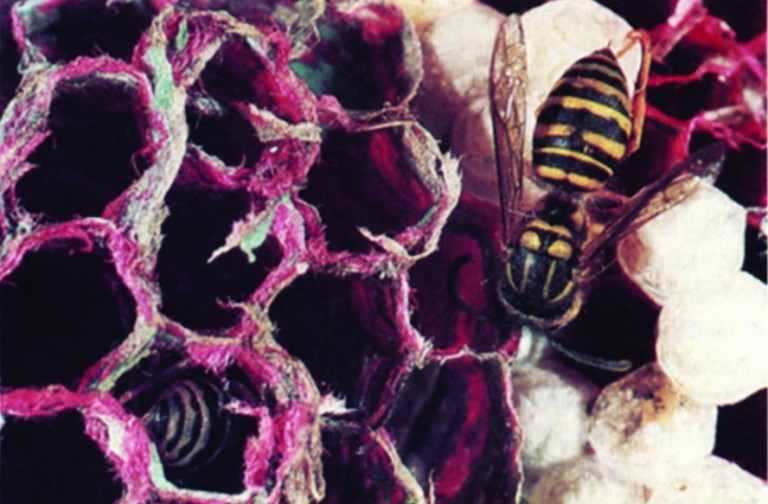
Figure 2. Southern yellowjacket, Vespula squamosa (Hymenoptera: Vespidae) on nest.
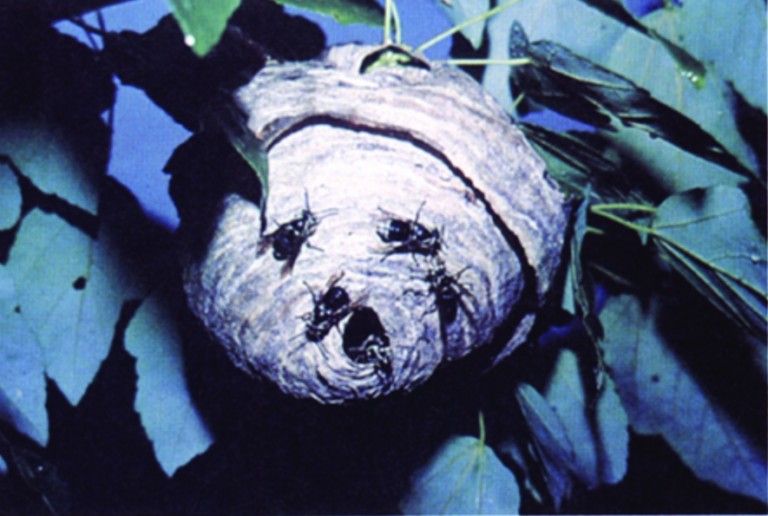
Figure 3. Baldfaced hornet, Dolichovespula maculata (Hymenoptera: Vespidae) and nest.
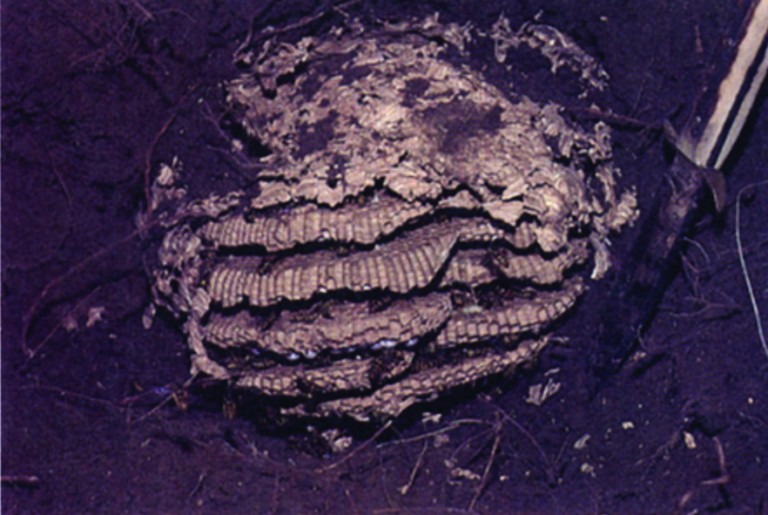
Figure 4. Exposed underground nest of eastern yellowjacket, Vespula maculifrons (Hymenoptera: Vespidae).
Due to their large colony size and defensive nature, yellowjackets are more aggressive than paper wasps. Yellowjackets have effective means of defending their colonies. They often have “guards” at their nest entrances, and the colony can easily be disturbed by rapid movement and vibrations near the nest. For this reason, one will almost certainly be stung if a lawn mower or trimmer is used near a yellowjacket nest. In some species, an alarm chemical is released upon stinging that causes nestmates to join the attack. Social wasps do not lose their sting after an attack, as honey bees do, and can sting repeatedly. Thus, multiple stings can be inflicted by yellowjackets in a very short time.
The nesting biology of yellowjackets is similar to that described for paper wasps,
but with a few exceptions of relevance to their stinging hazard. The colony usually
survives longer than most paper wasp colonies. Yellowjackets are usually active until
late fall (September to early December), resulting in more time for interactions with
humans. Yellowjackets, like the paper wasps, usually prey on live insects, but some
species also scavenge for protein and sugars at carrion, garbage, picnic, and recreation
sites; meat-packing plants; areas where fruit has fallen from trees; and food-processing
plants. This scavenging habit, the aggressiveness of individual workers, and the peak
population levels in the fall make yellowjackets a serious stinging hazard at these
feeding sites.
Yellowjackets
- Usually yellow and black striped, yellowjackets are most noticeable in the fall.
- Large nests are built underground, in wall voids, and sometimes aerially.
- Yellowjackets are very defensive around their colony; multiple stings are likely.
- Picnic and garbage sites are likely spots to find yellowjackets scavenging for sweets and protein.
Solitary Wasps
Most solitary wasps do not have an organized social life like the paper wasps and yellowjackets, as each female builds and cares for her own nest. The female wasp stings insect or spider prey to paralyze it, returns it back to a soil burrow or mud nest, lays an egg on it, and finally seals up the prey and egg into a cell. Most species repeat this process several times and thus prepare a number of cells, each with food, for its young. A number of these individual cells constitutes a nest. There are thousands of species of solitary wasps worldwide of various shapes, sizes, and colors and a wide diversity of nesting habits. These wasps are not very defensive of the nest and seldom, if ever, sting humans. Nevertheless, some species build nests around dwellings, and due to their continual flight activity to and from the nest, appear to be a stinging threat.
Potter Wasps
Potter wasps build little clay pots for nests, usually attached to twigs but occasionally under roof eaves and carports. They prey on caterpillars, which they store in their nests.
Mud-Daubers
Mud-daubers commonly build their mud nest (Figure 5) in attics, porches, and carports and stockpile them with spiders. These slender wasps are about the size of the paper wasps, but are conspicuously different due to their thread-like “waist” connecting the abdomen to the rest of the body. The black and yellow mud-dauber (Figure 5) is commonly encountered, but black and metallic blue-black species may be observed around dwellings. These wasps are often seen around moist areas, such as near the edges of ponds, outside water faucets, and near watered lawns, where they gather mud for their nest. Consequently, their frequent trips from their “mud hole” to their nest and back again makes them quite obvious. Despite their conspicuous flight path near our residences, they do not “attack” and sting humans. Occasionally, they build their nests in small cavities or holes in outside equipment, which may result in equipment failure.

Figure 5. Mud-dauber, Sceliphron caementarium (Hymenoptera: Sphecidae) on nest.
Spider Wasps
Spider wasps, such as the large (1- to 2 1/2-inch) tarantula hawks, may be seen flying low along the grass or vegetation in search of spiders, which they attack, sting, paralyze, and carry to a soil burrow to lay their eggs with. They are usually shiny blue or black, sometimes with orange or yellow markings on their legs and antennae. They are not a stinging hazard, but children running barefoot across a lawn could be stung by stepping on a wasp hunting in the grass.
Cicada killers
The cicada killer has a large, black body, marked with yellow like the yellowjackets, but is much larger (1 1/2 inch) (Figure 6). This wasp preys upon cicadas and carries its stung prey to a soil burrow often in lawns, gardens, nursery beds, and golf courses. The female digs a fairly large burrow, 1/2 inch diameter and several inches deep. Soil is often mounded around the entrance to the burrow. Although they do not establish colonies, many females may build their individual burrows close to each other, resulting in nesting aggregations of a few to several dozen wasps. The female will not sting unless handled but could inflict a painful sting to people working on lawns or barefoot children playing on the lawn. The males are also very large, and because they fly around the nesting area and even approach people, they can appear threatening. However, the males, as those of all wasps, cannot sting because they lack a sting apparatus.
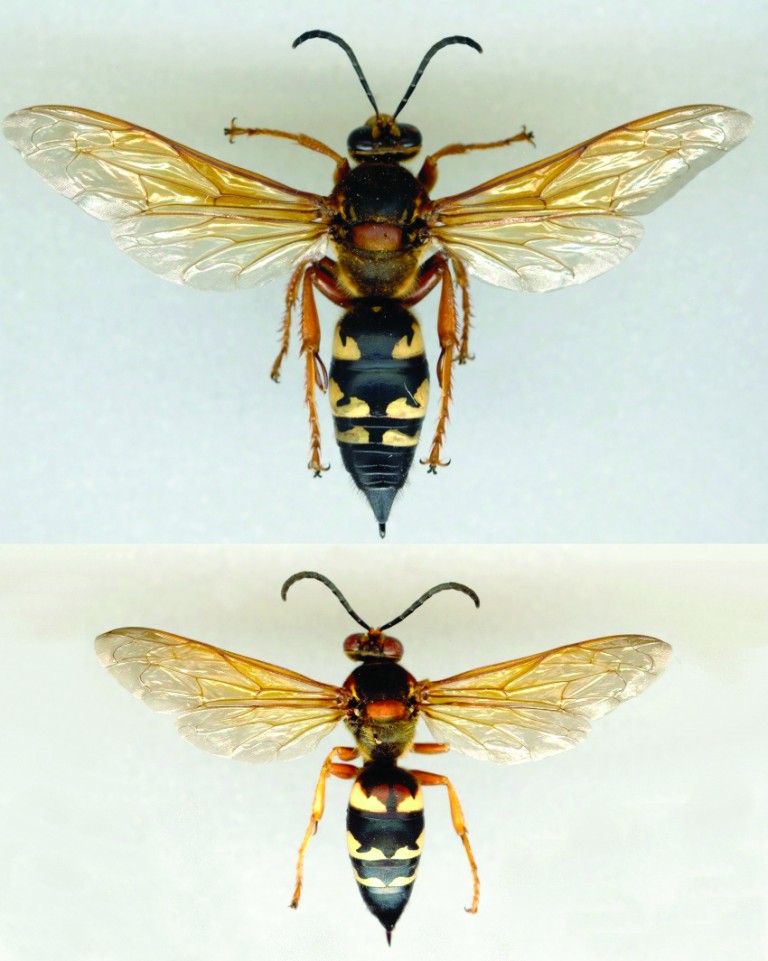
Figure 6. Male (top) and female (bottom) cicada killer Sphecius speciosus, (Hymenoptera: Vespidae).
Avoidance and Control
Solitary Wasps
Since solitary wasps are not a stinging hazard, it is usually best to let them nest. Most species are beneficial, as they prey on unwanted insects, and besides, it can be a fascinating experience observing their nest-building activities. However, if these species are causing damage to structures, paint, or equipment, the best remedy is to simply knock down or remove their mud nests. To date, there are no repellents that prevent mud-daubers and other solitary wasps from nesting around structures. Sealing crevices, screening vents, and keeping garage doors and windows shut would reduce much of the nesting activity. The nest entrances of the cicada killer can be sprayed with diazinon or Sevin dust during times of inactivity.
Social Wasps
Paper wasps and yellowjackets and their nests should be avoided and not disturbed. Wasps and bees often visit garbage cans in picnic areas and other recreation sites, so it is best to avoid sitting or standing next to such sites. When wasps are common in recreation areas, carefully look for wasps and bees before sitting on the ground and check your food or drink before consumption. Stings inside the mouth and throat are particularly dangerous because of the potential of swelling and closing off the windpipe. When in wasp-infested areas, avoid wearing sweet-smelling colognes, perfumes, and hair sprays and bright orange, yellow, and blue clothing, as they will attract flying wasps. Khaki, tan, and dark colors are less attractive to wasps. If a wasp does approach you, it is best to remain still or move away slowly, because rapid movements such as swatting may stimulate stinging. However, if you have already disturbed a nest or have been stung, it is best to rapidly leave the area, as an alarmed wasp can cause other nestmates to join in the attack. Under these circumstances, defending wasps are attracted to dark or black objects and direct their stinging at the head.
Paper wasps not only nest on structures, but also in trees and shrubs around houses,
so caution is warranted when trimming plants. In the fall, mating aggregations of
paper wasps may concern persons working on tall buildings, towers, and other elevated
structures. Hibernation aggregations of reproductive females also occur in protected
places inside or near man-made structures and may cause concern in the fall, warm
days of winter, and the early spring when the wasps become active. Some of these wasps
may enter a building and are often noticed flying against windows. Generally, these
females are less aggressive than nesting females. If such aggregations must be controlled,
the pressurized aerosol products registered for wasp control (e.g., Hornet and Wasp
Spray) are effective.
“Do’s and Dont’s” of Avoiding Stinging Wasps
Do Not use sweet-smelling colognes, perfumes, and hair sprays in wasp areas.
Do Not wear bright-colored clothing;wear tan, khaki, and dark-colored clothes.
Do Not picnic, sit, or stand near trash cans, fallen fruit, or other wasp feeding sites.
Do Not swat or move rapidly when a wasp visits you or your food or drink; move slowly.
Do Not approach a nest; if you do disturb a nest, run away from attacking wasps.
Do cleanup food and drink refuse, clean trash cans, and fit them with a tight lid to reduce wasp visits.
Destruction of most social wasp colonies can be difficult and dangerous, so it is often best left to experienced personnel such as pest control operators. However, paper wasp nests can be controlled with pressurized aerosol products containing quick knockdown chemicals such as resmethrin and pyrethrins. Stand back from the colony and completely soak the nest with the aerosol.
Controlling any nest, especially the large colonies of paper wasps and all yellowjacket
nests, is best done only when wearing protective clothing such as a bee suit. Nest
destruction should be attempted at night when wasps are less active, and all are in
the nest. The aerosol cans may be sufficient for paper wasp colonies; however, a pressurized
aerosol generator with a fast-acting insecticide (e.g., resmethrin) is best used for
yellowjacket colonies.
Underground yellowjacket nests can usually be controlled safely and effectively by
applying the insecticide (e.g., 1% propoxur or dichlorvos or resmethrin or 5% carbaryl
dust) down the entrance in the soil after dark. Use a red light (e.g., a flashlight
with red cellophane taped over the lens) to locate the entrance, as this light will
not provoke the wasps. Be careful when walking close to the entrance, since most nests
are just below the surface and any vibrations can cause the workers to defend the
colony. After insecticide treatment, it is best to plug the entrance with insecticide-soaked
cotton to prevent insecticide vapors from escaping and to kill any returning workers
that contact the cotton.
Structural nests (e.g., wall voids) are best controlled by an initial application
of 5% carbaryl dust with a generator, followed quickly with 1% resmethrin. The latter
can be applied by inserting the wand of the aerosol generator into the entrance hole
and spraying material for about 30 seconds. Again, the entrance should be plugged,
preferably with steel wool, and dusted with 5% carbaryl to kill returning wasps. Watch
the site for a few days and reapply this treatment if colony activity continues.
Aerial nests of the bald-faced hornet should not be controlled unless they are in
a site that directly threatens human activity. Many standard pressurized products
are not effective for these colonies, since their nests can be quite populous and
have several layers of paper envelope protecting the inner combs. Instead, use a product
with synergized pyrethrins and petroleum distillates (e.g., Wasp Freeze), which kill
or “knock down” the wasps upon contact. Direct the spray at the nest entrance, typically
at the bottom of the nest, and thoroughly soak the entire nest. After insecticide
treatment, aerial nests may be discarded in a sealable container.
Sanitation and cleanliness around homes, recreation areas, and food-related industries
is necessary to discourage scavenging yellowjackets. Garbage cans and other refuse
containers should be kept covered with tight-fitting lids and emptied often, especially
in the fall. Cleaning empty cans with an ammonia solution can discourage buildup of
food odors attractive to wasps. Treating trash containers with dichlorvos spray or
by securing a large piece of dichlorvos-impregnated strip [e.g., Vapona, No Pest Strip]
to the underside of the garbage can lid can repel or even kill scavenging yellowjackets.
However, such treatments may also kill honey bees that visit the trash can for sugary
liquids. Killing beneficial honey bees can potentially invite a lawsuit by local beekeepers,
and state laws protect honey bees from being poisoned. Insecticide-treated meat baits
and synthetic attractants have shown limited success against some yellowjackets but
are not effective against the species in Oklahoma. Consequently, we do not recommend
any of the commercial traps available at garden centers, especially those that use
sugar water as bait, since such traps will also capture beneficial honey bees and
other wasps and bees that do not normally bother humans.
Controlling Wasp Nests
Mud-Daubers
- Remove mud nests and seal off garages or buildings; insecticides are not needed.
Paper Wasps
- Use standard aerosol “wasp sprays” with rapid knockdown insecticide and “freezing” component.
Yellowjackets
- Seek professional help for large nests and nests in wall voids or attics.
- Use protective clothing and an aerosol generator with rapid knockdown insecticide.
- Control nests at night when most wasps are inside.
- Spray or pour insecticide directly into nest entrance and then plug the entrance with insecticide-soaked cotton.
Medical Importance and Treatment
The venom of stinging wasps and bees contain compounds which cause intense pain along
with swelling and redness. Consequently, stings around the head, eyes, necks, and
inside the mouth and throat are especially serious. Since some yellowjackets are scavengers
associated with unsanitary conditions, there is a possibility that a secondary infection
may develop at the sting site. Of even greater importance, however, is the possibility
of an allergic reaction to the venom from just one sting. Such reactions may range
from swelling of part or all of the limb where the sting was received to the very
serious, sometimes fatal, shock response involving several body systems. A severe
(i.e., systemic) reaction can result in hives and itching throughout the body, nausea,
vomiting, asthma, dizziness, confusion, slurred speech, drop in blood pressure, or
unconsciousness, and can possibly result in death. These complications in allergic
individuals may happen very quickly, within 10 to 30 minutes of a sting, and most
reported deaths occur within one hour. Estimates of deaths in the United States due
to insect stings range from 50 to 100 persons annually, but it is likely that many
additional fatalities are not recorded, since the symptoms are very similar to those
of heart attacks. Although insect sting deaths constitute a minor health problem,
it is estimated that at least 2.5 million Americans have some degree of increased
sensitivity to stinging insects. Unfortunately, medical allergists cannot accurately
predict who among this hypersensitive population may have a life-threatening reaction
upon the next sting.
If you are stung, you should wash the actual sting site with soap and water to minimize
the possibility of secondary infection and apply ice packs or a baking soda, meat
tenderizer, and water paste to reduce the amount of venom uptake, pain, and local
swelling. Antihistamines such as Benadryl® can be helpful to lessen the swelling in
mildly allergic reactions. If serious systemic reactions occur, seek a physician’s
help immediately. The immediate injection of epinephrine is the initial step to combat
a life-threatening anaphylactic reaction. If you think you may be allergic to stinging
insects, see an allergist who can verify a patient’s hypersensitivity by performing
a scratch skin test or intradermal skin test. Most physicians recommend that persons
with demonstrated hypersensitivity wear an identification tag and carry a small sting
emergency kit, containing antihistamines and a syringe of epinephrine. Such kits are
relatively inexpensive and are available with a doctor’s prescription (e.g., Ana-kit
from Hollister-Stier laboratories and Epi-Pen from Center laboratories). People at
especially high risk of a fatal reaction should consult their physician to consider
desensitization procedures that gradually build up a tolerance to venom and reduce
the likelihood of a serious systemic reaction.
What to Do When Stung
- Wash sting site and apply ice pack to minimize swelling.
- Apply baking soda and meat tenderizer in a water paste to reduce venom spread and swelling.
- Take antihistamine to lessen swelling and mild allergic responses.
- If serious reactions (i.e., dizziness, asthma, nausea, blood pressure drop, etc.) occur, seek a doctor IMMEDIATELY. Only the immediate injection of epinephrine will combat this life threatening reaction.
